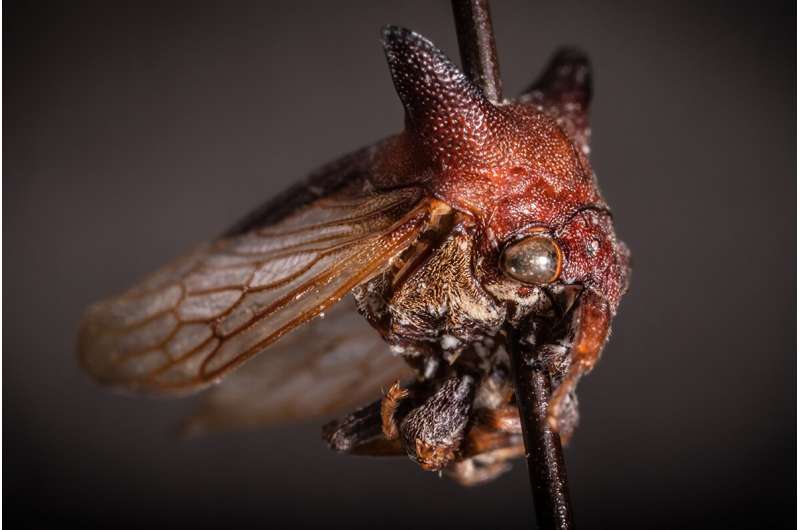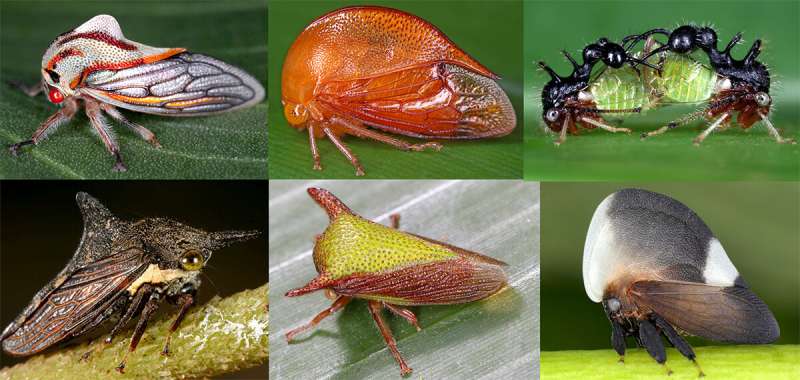Grad student names new treehopper species after Lady Gaga

According to Brendan Morris, a graduate student at the University of Illinois at Urbana-Champaign, treehoppers are the wackiest, most astonishing bugs most people have never heard of. They are morphological wonders, sporting bizarre protuberances that look like horns, gnarled branches, antlers, fruiting fungi, brightly colored flags or dead plant leaves. Treehoppers suck on plant juices. They sing to each other by vibrating plant stems. And they are an important food source for other forest creatures.
"I love outrageous forms and colors," said Morris, who studies entomology at the U. of I. "It blows my mind that a group that is roughly 40 million years old has so much diversity of form—diversity, I would argue, that we don't see in any other family of insects."
To draw attention to this group, Morris named a newly discovered treehopper species after Lady Gaga, a musical performer who has her own flamboyant, shape-shifting style.
"If there is going to be a Lady Gaga bug, it's going to be a treehopper, because they've got these crazy horns, they have this wacky fashion sense about them," Morris said. "They're unlike anything you've ever seen before."
The insect, now known as Kaikaia gaga, also represents a new genus of treehopper, Morris and his coauthor, INHS entomologist Christopher Dietrich, reported in the journal Zootaxa. Her features—the bug is female—differentiate her from other treehoppers found with her nearly 30 years ago in a tropical forest near the Pacific coast of Nicaragua. She was one of about 1,000 specimens Morris borrowed from the Carnegie Museum of Natural History in Pittsburgh as part of his research.
Insect taxonomists look primarily at head and body shapes, leg and body hairs and genitalia to differentiate one bug group from another. When Morris looked at this particular specimen under a stereoscope, he noticed some unusual characteristics.

A part of the thorax—just behind the head—was horned, like many other specimens, but the leg hairs differentiated it from the other tribes of treehoppers he had seen.
"Also, the frontoclypeus, which is kind of like the face, was shaped totally different," Morris said. "And the genitalia looked more like treehoppers from the Caribbean or this Old-World group, Beaufortianini."
That last observation was strange, because treehoppers are believed to have originated in the Americas. More research—specifically genetic research—will begin to explain why K. gaga shares traits with Old-World treehoppers.
Morris has tried to extract DNA from his one, 30-year-old specimen, but so far has had no luck. He will travel to Nicaragua to see if he can find any living Kaikaia gaga specimens in the same forest where this one was collected.
In the meantime, he is working hard to share his enthusiasm for this largely overlooked bug group, which is found in most forested areas of the planet.
"Treehoppers are wacky, and I think that makes them especially suited to be spokesbugs for the wide range of habitats they use," Morris said.
More information: T K Wood, Diversity in the New World Membracidae, Annual Review of Entomology (2003). DOI: 10.1146/annurev.en.38.010193.002205
Journal information: Zootaxa
Provided by University of Illinois at Urbana-Champaign

















